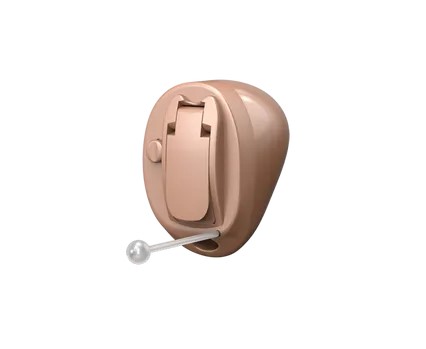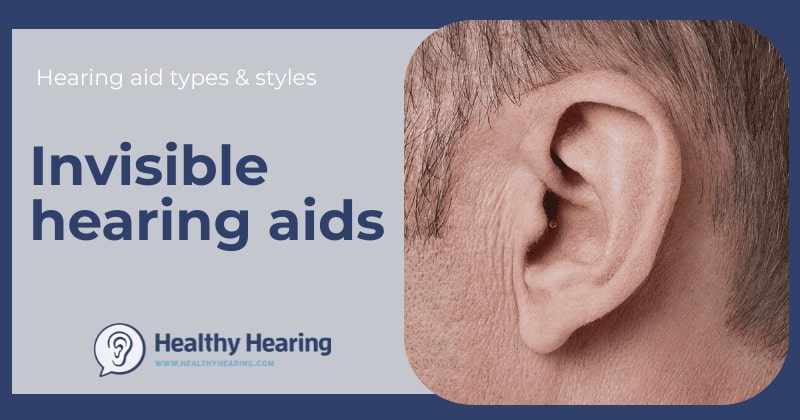|
www.HealthyHearing.com |
Are invisible hearing aids right for you?Understanding the benefits and drawbacks
Contributed by Emily Ostrowski, content manager, Healthy Hearing Key points:
What are invisible hearing aids?"Invisible" hearing aids are small devices that tuck into the ear canal. Hearing care providers refer to them as "invisible-in-the-canal" (IIC) hearing aids. What do they look like?hearing aid. Invisible hearing aids typically come with an outer shell (exterior) in different skin tones, to enhance their invisibility. Some have a push-button to let you change the volume or the settings. There is also an "on/off" switch and a vent to let air through, and sometimes a pull-out string. What's inside?Considering they are roughly the size of a candy corn, invisible hearing aids pack a lot of technology. Most models contain:
What are the advantages?Invisible hearing aids are a good choice for some people with mild to moderate hearing loss. Advantages include:
Who is a good candidate for invisible hearing aids?You may be a good candidate for IIC hearing aids if you
Who shouldn't get invisible hearing aids?Invisible hearing aids aren't right for everyone. They are not a good option for:
Other disadvantages include:
Additionally, some users just don't like the feel of the device in their ear canal as it can feel like their ears are "plugged up" when they wear IIC hearing aids. The stigma of hearing lossAre you drawn to the idea of invisible hearing aids because you don't want anyone to know that you wear them? The appeal is understandable, especially when you consider the ongoing stigma of wearing hearing aids. Many new users worry that others will consider them "old" or "less capable" if they see their devices. Yet when you wear hearing aids, it's actually the opposite: You won't constantly be asking "what?" or automatically smiling and nodding when someone asks you an important question. You'll be able to stay engaged and interact in meaningful ways with others. Finding the right hearing aid for youSince treating hearing loss has such a meaningful impact your physical and mental health, it's important to work with a qualified hearing healthcare provider to find best hearing aids to meet your individual needs. "I would say in our clinic most people express wanting a hearing aid that is small and subtle, but only about 5-10% ask for a hearing aid that is completely invisible in the ear," said Dr. Elizabeth Diamond, Au.D., at Priority Hearing & Tinnitus in San Tan Valley, AZ. We informally polled several other experts from our hearing directory who echoed the notion that patients often expressed an interest in smaller hearing aids. However, all providers reported that invisible-in-the-canal hearing aids account for less than 10% of their monthly sales. Other in-the-ear hearing aid optionsIIC hearing aids are not the only in-the-ear model. Additional styles include in-the-canal, half-shell and full-shell hearing aids. They are not quite as small as IIC models, but still tiny and may be a better fit for your particular hearing needs. Read more: Hearing aid types and styles "Behind the ear" styles more powerful while still being discreet.jpg)
features than invisible hearing aids, such as rechargeable batteries. Behind-the-ear (BTE) and receiver-in-canal (RIC) hearing aids are both worn behind the ear. RIC models tend to be smaller. However, despite what you may think, even modern BTE devices are quite discreet. Advances in technology have allowed manufactures to create smaller, sleeker devices that sit comfortably behind the ear. Like IIC devices, they also come in colors that can blend with hair or skin tones, making them less conspicuous. Additional benefits include:
These models are an effective and popular choice for many people with hearing loss. The majority of providers we polled said that RIC and BTE hearing aids make up more than 80% of their monthly sales. Bottom lineToday there are a wide variety of hearing aid styles that can treat most forms of hearing loss. Keep an open mind when deciding on what model works best for you and communicate your preferences with your hearing healthcare provider. At the end of the day, as Dr. Diamond noted, "The best hearing aid is the one patients want and will wear consistently." To find treatment options for yourself our a loved one, visit our comprehensive hearing clinic directory to find an expert in your area. Emily Ostrowski, content manager, Healthy Hearing
Related Help Pages:
Hearing aids Types of hearing aids Technology Bluetooth Reviews and comparisons Batteries
|
Featured clinics near me
Earzlink Hearing Care - Reynoldsburg
7668 Slate Ridge Blvd
Reynoldsburg, OH 43068

Find a clinic
Need a hearing test but not sure which clinic to choose?
Call 1-877-872-7165 for help setting up a hearing test appointment.




 Emily is an experienced journalist and medical content writer based in Maine. Passionate about delivering enlightening and accurate content, she is committed to empowering people to make informed choices regarding their hearing health.
Emily is an experienced journalist and medical content writer based in Maine. Passionate about delivering enlightening and accurate content, she is committed to empowering people to make informed choices regarding their hearing health.